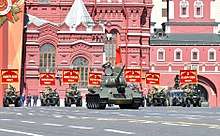Victory Day Parades
| Victory Day Parades | |
|---|---|
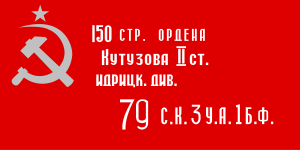 Soviet Victory Banner | |
| Official name | Russian: День Победы Ukrainian: День Перемоги Belarusian: дзень Перамогі |
| Also called | Victory Parades |
| Observed by | Russia, Belarus, Ukraine, former Soviet countries |
| Observances | Moscow, Minsk, Kiev, Astana |
| Date | 9 May |
| Next time | 9 May 2019 |
| Frequency | annual |
Victory Day Parades are celebrated on the 9th of May in various post-soviet nations, primarily Russia, Kazakhstan, Belarus, and formerly Ukraine. The Ukrainian government in 2015 had renamed the holiday as "Victory Day over Nazism in World War II" as part of decommunization laws, but even after the change a vast amount of the populous still honors Ukrainian-Soviet troops who fought in World War 2 in the traditional Victory Day style.
List of parades
Soviet Union 
During the entire history of the Soviet Union, only a total of four parades ever took place in Moscow and throughout the entire Soviet Union. In December 1947 the Presidium of the Supreme Soviet under Josef Stalin, decreed that May 9th (Victory Day) would become a working day, effectively making the celebrations cancelled and ceased completely. Stalin was also not eager to see the maimed Red Army soldiers who fought victoriously during the war, parade on Red Square, as he had no need for heroes. Stalin had many of the veterans removed from the city limits, and the removal of the holiday helped build his image of being the great commander and hero of the war, effectively broadening his Cult of Personality during his reign of power.
However, on April 26, 1965, nearly twenty years after the first parade, under Leonid Brezhnev, the Presidium of the Supreme Soviet reversed the actions made in 1947, thus making May 9 a non-working holiday, this would be the first time Victory Day was made as an actual holiday. On May 9, 1965 the second Victory Day parade took place in Moscow, this Victory Day celebration also saw veterans obtain the first jubilee medal for "Twenty Years of Victory" in honor of the 20th year anniversary since the Allied victory in Europe against Nazi Germany.[1] Further parades would be held in 1985 and 1990.
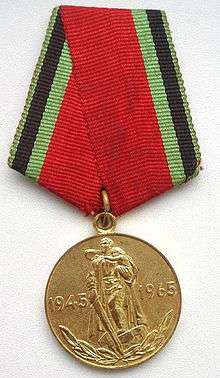
Parades:
- Moscow Victory Parade of 1945
- 1965 Moscow Victory Day Parade
- 1985 Moscow Victory Day Parade
- 1990 Moscow Victory Day Parade
Russia 
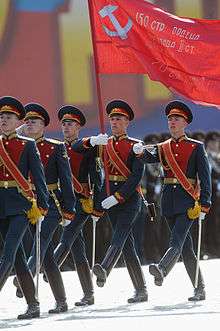
Today, Russia, as the largest of the countries of the former Soviet Union, continues the practice of parades held in honor of the victory won in the Great Patriotic War - the Eastern Front of the Second World War as called by the Soviet Union.
Parades in Moscow:
- 1995 Moscow Victory Day Parades
- 1996 Moscow Victory Day Parade
- 1997 Moscow Victory Day Parade
- 1998 Moscow Victory Day Parade
- 1999 Moscow Victory Day Parade
- 2000 Moscow Victory Day Parade
- 2001 Moscow Victory Day Parade
- 2002 Moscow Victory Day Parade
- 2003 Moscow Victory Day Parade
- 2004 Moscow Victory Day Parade
- 2005 Moscow Victory Day Parade
- 2006 Moscow Victory Day Parade
- 2007 Moscow Victory Day Parade
- 2008 Moscow Victory Day Parade
- 2009 Moscow Victory Day Parade
- 2010 Moscow Victory Day Parade
- 2011 Moscow Victory Day Parade
- 2012 Moscow Victory Day Parade
- 2013 Moscow Victory Day Parade
- 2014 Moscow Victory Day Parade
- 2015 Moscow Victory Day Parade
- 2016 Moscow Victory Day Parade
- 2017 Moscow Victory Day Parade
- 2018 Moscow Victory Day Parade
Parades in Saint Petersburg:

- 2000 Saint Petersburg Victory Day Parade
- 2001 Saint Petersburg Victory Day Parade
- 2002 Saint Petersburg Victory Day Parade
- 2003 Saint Petersburg Victory Day Parade
- 2004 Saint Petersburg Victory Day Parade
- 2005 Saint Petersburg Victory Day Parade
- 2006 Saint Petersburg Victory Day Parade
- 2007 Saint Petersburg Victory Day Parade
- 2008 Saint Petersburg Victory Day Parade
- 2009 Saint Petersburg Victory Day Parade
- 2010 Saint Petersburg Victory Day Parade
- 2011 Saint Petersburg Victory Day Parade
- 2012 Saint Petersburg Victory Day Parade
- 2013 Saint Petersburg Victory Day Parade
- 2014 Saint Petersburg Victory Day Parade
- 2015 Saint Petersburg Victory Day Parade
- 2016 Saint Petersburg Victory Day Parade
- 2017 Saint Petersburg Victory Day Parade
- 2018 Saint Petersburg Victory Day Parade
Ukraine 
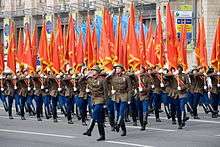
Ukraine, as the second largest former Soviet republic in terms of population, suffered massive casualties during the war. Ukrainians were the largest minority ethnic group of the USSR, and had seen the full force of the Nazi invasion that struck a huge blow to the Ukrainian population. An estimated 1,377,400 Ukrainian servicemen and women of the Soviet Armed Forces lost their lives fighting against Wehrmacht troops during the war. Although Victory Day as a holiday has been altered completely and renamed as a completely different holiday (Victory Day over Nazism in World War II), many Ukrainians still honor their forefathers in the traditional Victory Day style. Only in the rebel breakaway regions of Donetsk and Luhansk do the people completely celebrate the traditional Victory Day parades with military vehicles and soldiers marching past the main squares.
Parades:
- 1995 Kiev Victory Day Parade
- 2001 Kiev Victory Day Parade
- 2010 Kiev Victory Day Parade
- 2011 Kiev Victory Day Parade
- 2013 Kiev Victory Day Parade[2]
Belarus 
Parades:
- 1995 Minsk Victory Day Parade
- 2005 Minsk Victory Day Parade[3]
- 2010 Minsk Victory Day Parade[4]
- 2015 Minsk Victory Day Parade[5]
Kazakhstan 
Parades:
- 1995 Almaty Victory Day Parade[6]
- 2015 Astana Victory Day Parade[7]
Kyrgyzstan 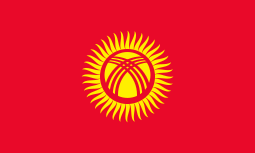
Parades:
- 2015 Bishkek Victory Day Parade[8]
Baltics 


The three Baltic republics: Estonia, Latvia and Lithuania do not officially celebrate Victory Day, as all three consider it a reminder of an illegal Soviet occupation, although a shared minority in the Baltic's retains the tradition of celebrating, primarily from Latvians, Lithuanians, Estonians, and Russians who either fought in the Red Army or have family that fought in the war.
Expanded summary of the parades within the CIS
As Victory Day is the principal military holiday of Russia and of almost all member countries of the Commonwealth of Independent States (except the Baltics and the Ukraine), the celebrations in Moscow and other capital cities thus serve as national events to mark such an important holiday for millions of people, marking the anniversary of the capitulation of Nazi Germany in 1945. The annual or semiannual parades mark the Allied victory in World War II on the Eastern Front, on the same day as the signing of the German act of capitulation to the victorious Allies in Berlin, at midnight of May 9, 1945 (Russian time), officially concluding the Second World War in Europe and northern parts of Africa.
Red Square, Moscow
The most important parade of those being held on May 9 is the one held on Moscow's Red Square, with the President of Russia as the guest of honor and keynote speaker in virtue of his constiutional mandate as Supreme Commander of the Russian Armed Forces. On the morning of the day, an estimated 14,000 military personnel, including a regiment of female cadets and youth cadets, assemble by battalions on the square together with the Massed Bands of around 1,100 bandsmen under the direction of the Senior Director of Music of the Military Band Service of the Armed Forces of Russia (an appointment bestowed to either a Colonel or a general rank officer), together with more than 178 vehicles and 3,500 vehicle crews assembled on Tverskaya Street just north of the Manezhnaya Square, Moscow, during the major parades a battalion or company of historical Red Army vehicles, estimated at around 36 vehicles and composed of just the T-34, GAZ-67 and the SU-100 plus the optional BM-13N (or at around 260 when counting other vehicles of the war which would take part just like in the parades of 1985 and 1990) assemble on the street as well with modern military hadware. At the air bases outside Moscow (in areas like Kubinka), more than 80 aircraft are assembled with their aircrews for the flypast segment.
The celebrations begin at 9:50 am Moscow Standard Time with the arrival of the President and the Prime Minister of Russia to a special grandstand in front of Lenin's Mausoleum, where 6 of the past parades were reviewed by national leaders. They greet the Chief of the General Staff of the Armed Forces, service commanders, deputy ministers in the Ministry of Defence and commanders of the support units within the Armed Forces, together with veterans, veterans' families and representatives of the Suvorov and Nakhimov Schools assembled.To the left and right of the grandstand are the stands wherein veterans, veterans' families and descendants and families of personnel killed in action are gathered. In between the grandstand to the south of the stands are two platoons of armed linemen and markers from the 154th Preobrazhensky Independent Commandant's Regiment in the Imperial-styled military uniforms and some unarmed half-companies of the Kremlin Regiment, both of which would be later taking post to mark the distance of the troops marching past and to line the square's western side facing the Kremlin. At the square, the parade commander (usually a Colonel General with the billet of Commander of the Ground Forces or as the Deputy Chief of General Staff) takes his place in a special Zil limousine, having just received the report on the readiness of the parade from the commandant of the Combined Arms Academy.
As the Spasskaya Tower of the Kremlin sounds the chimes at 10am the parade commander orders the parade to present arms as the 154th PICR's 1st Honor Guard Company Colour Guard, to the melody of The Sacred War being played by the Massed Bands, marches into the square and past the dignitaries with guard carrying both the Flag of Russia and the Victory Banner. As the colour guards approach the grandstand, the colour officers execute eyes left. This is followed by the parade being commanded to stand at ease after the colours take their place at the northwest end of the square fronting the State Historical Museum, besides the colour of the Armed Forces. Then the Minister of Defence (usually a billet of a General of the Army) is driven on the limousine to the center of the square nearest the tribune, the parade presenting arms again at this point. The parade commander informs him of the readiness of the parade to be inspected. The report is received, and to the tune of the Massed Bands the Minister and the parade commander are driven to inspect the parading contingents each together with the bands. As the limousines stop the Minister sends Victory Day greetings to each of the parading contingents, in which they respond with a threefold loud Oorah that is heard all over the grounds. After the final greeting, the Massed Bands strike up to Slavsya from A Life for the Tsar as the PC returns to his place, the Minister driven to the grandstand amidst louds shouts of Oorah by the parade contingents where he dismounts the limousine and the Corps of Drums of the Moscow Military Music College, an affiliate of the Suvorov Military Schools, take their place behind the parade commander's car led by the Commandant of the College and the college colour guard. The parade is ordered to stand at ease after the Minister informs the President that the parade is formed up for the march past in review and its inspection officially completed. In the 1965, 1985 and 1990 parades, the limousines would inspect the personnel of the mobile column at the Manezhnaya Square, in remembrance of the mounted inspection of the original 1945 parade. When should it happen any point in the future the Iberian Gate and Chapel's gates open for the limousines to pass through and the PC and the Minister pay respects to the holy Marian icon of the Panagia Portaitissa at the small chapel, following this the Minister, together with the PC, are driven in their limousines past the Four Seasons Hotel Moscow and then proceed the south end of Tverskaya Street at the north end of the square to inspect the troops comprising the mobile column formed into battalions, after the inspection is finished then will the bands at the Red Square play Slavsya as the vehicles are driven past the east side of the Manezhnaya Square first and then into Red Square itself. In either case, following the report of the Minister of Defence, the keynote holiday address to the nation of the President follows, preceded by a fanfare by the Massed Bands, usually Govovin's Moscow Fanfare. A moment of silence, since 2014, features as part of the keynote address.
As the president finishes the address and a threefold Oorah resounds all over the square by the entire parade assembled and the honor guard presents arms, the Massed Bands play the National Anthem of Russia and a ceremonial battery armed with the 76 mm divisional gun M1942 (ZiS-3) fire a 21-gun salute. As the anthem ends, the bands sound Retreat and the parade commander orders the parade to commence the march past in the following manner:
- Parade... attention! Ceremonial march past!
Form battalions! Distance by a single lineman! First battalion will remain in the right, remainder... left.. turn!
Slope.. arms!
- Parade... attention! Ceremonial march past!
As the command is given to start the linemen take their places and the field markers also as well at the south end of the square. As the PC ends the commands with Eyes to the right, forward, quick march! the Corps of Drums of the Moscow Military Music College, as is their tradition since 1938, march first to the tune of the "General Miloradovich" by one of its late alumni, Lieutenant General Valery Khalilov, one of the longest serving Senior Directors of Music of the Military Band Service and conductor of the Moscow area massed bands from 2002 to 2016, being played by the drummers and fifers. As the massed bands start playing the Corps of Drums stop playing by the signal of the Corps Drum Major and swings its drumsticks while on the eyes right. The Corps is followed by the colour guard of the 154th PICR and its 1st Honor Guard Company, during jubilee parades, the colour guard is followed by a company of colour bearers carrying the front standards in the order of their marchpast in the 1945 Victory Parade and their escorts, colours from the regiments, brigades and divisions which took part in the original 1945 parade and a historical unit of servicemen in period uniforms, optionally joined by the Kuban Cossacks, in memory of their contingent which marched past on that very parade, and the Escort Cavalry Squadron of the Kremlin Regiment plus a number of international contingents. This is followed by the rest of the parade ground column, starting with the youth contingents and by the Combined Arms Academy, in the following order starting 2010:
- Youth contingents
- Survorov and Nakhimov Military Schools
- Cadet Corps colleges of the Armed Forces and other uniformed organizations
- Young Army Cadets National Movement Moscow Area (led by the Chairman, includes female students of the Moscow National Pensions School Cadet Corps)
- Russian Ground Forces
- Russian Aerospace Forces
- Russian Navy
- Battalion of female cadets of Armed Forces academies (starting 2016)
- Strategic Missile Troops
- Russian Airborne Troops
- Military Police (beginning 2018)
- NBC Troops
- Russian Railway Troops
- Border Service of the Federal Security Service
- Ministry of Emergency Situations
- National Guard of Russia Separate Operational Purpose Division (National Guard Forces Command)
- Military forces of the Western Military District
The ground column ends, as the massed bands play either Victory Day or Let's Go, with the traditional marchpast of the Moscow Higher Military Command School, which has been done since the golden jubilee October Revolution Day parade of 1967 as a commemoration of the school's importance as the first military officer cadet school to be established in modern-day Russia, the first time it had been seen last in the Victory Day parade ground column was in 1985 (the two battalions of the school's Corps of Cadets also march past the square in memory of the cadets who fought in the 1941 Battle of Moscow). With the ground segment competed the bands stop playing at the signal of the senior director and the senior drum majors and, to give way to the mobile column, march towards the facade of the GUM department store, with two sections of the MMMC Corps of Drums at either side of the bands, reflecting the formations of the massed bands alongside the Corps of Drums in the Red Square parades of the 1950s and the 1960s.
The mobile column starts with the drivepast of historical vehicles in jubilee years. In non-special anniversary years only a T-34/85 medium battle tank carrying the Victory Banner leads the column of tens of military vehicles and equipment.
Victors Avenue, Minsk
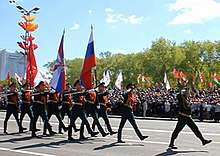
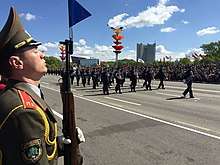
The parade commander (the Deputy Defense Minister bearing the rank of Major General) arrives on Victors Avenue to receive the report from the commander of the first parade formation (usually the Military Academy of Belarus). The President of Belarus then arrives at the grandstand in front of the Minsk Hero City Obelisk to await the start of the parade before 10:00 in the morning.
The parade commander gives the order to begin the review of the Minsk Garrison by the Defence Minister of Belarus, the parade presenting arms at that juncture and the Central Band of the Armed Forces of the Republic of Belarus, by itself a grouping of massed bands of the Armed Forces, beginning to play inspection music. Then as the limousines stop in front of the grandstand and the massed bands stop playing the Deputy Defense Minister of Belarus reports to the Defense Minister on the status of the parade. The Defense Minister then reviews the parading troops along the avenue. As the defense minister concludes the inspection of the troops, he reports to the president on the readiness of the parade. A minute of silence then takes place, followed by a performance of the National Anthem of Belarus (My Belarusy) by the massed bands. The president then delivers an address to the nation and congratulates the citizens on the holiday. As the president concludes the address, the parade commander then gives the order for the Minsk Garrison to get into their parade formations, and for the troops of the Honour Guard Company to take their post as linemen to mark the distance of the troops marching past the grandstand. The first unit to march, beating the snare drums, are the drummers of the Minsk Suvorov Military School, followed by a colour guard and the standards of the fronts which were involved in the 1944 Minsk Offensive.
Victory Park, Dushanbe

According to tradition, a wreath laying ceremony at the tomb of the unknown soldier takes place at Victory Park.[9] The ceremony is presided by the President of Tajikistan and the parade commander is a deputy minister in the Ministry of Defense holding the rank of a Lieutenant General.
Full order of the parade:
- Military Brass Band of the Commandant Regiment of the Ministry of Defense of Tajikistan
- Presidential National Guard
- Units of the Commandant Regiment of the Ministry of Defense
- Military Institute of the Ministry of Defense of Tajikistan
- Mastibek Tashmukhamedov Military Lyceum of the Ministry of Defense of Tajikistan
- Russian 201st Military Base
- Honor Guard Company of the Ministry of Defense of Tajikistan
Independence Square, Astana
Most Victory Day parades in Astana are held in connection with Defender of the Fatherland Day, which celebrates the founding of the Kazakh Armed Forces.
List of parades held in partly recognized states
Abkhazia 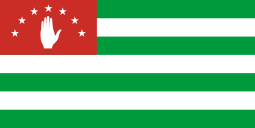
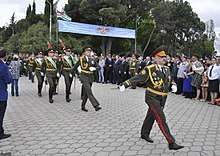
Parades:
- 2017 Sukhumi Victory Day Parade
- 2018 Sukhumi Victory Day Parade
South Ossetia 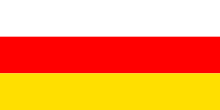
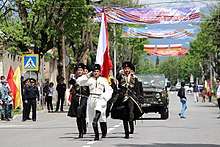
Parades:
- 2009 Tskhinvali Victory Day Parade
- 2017 Tskhinvali Victory Day Parade
- 2018 Tskhinvali Victory Day Parade
List of parades held in unrecognized states
Donetsk People's Republic 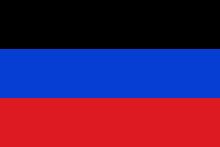
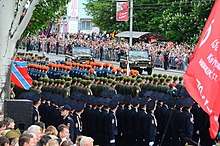
Parades:
- 2015 Donetsk Victory Day Parade
- 2016 Donetsk Victory Day Parade
- 2017 Donetsk Victory Day Parade
- 2018 Donetsk Victory Day Parade
Luhansk People's Republic 
Parades:
- 2015 Luhansk Victory Day Parade
- 2016 Luhansk Victory Day Parade
- 2017 Luhansk Victory Day Parade
- 2018 Luhansk Victory Day Parade
Transnistria 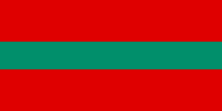
.jpg)
Parades:
- 2015 Tiraspol Victory Day Parade
- 2016 Tiraspol Victory Day Parade
- 2017 Tiraspol Victory Day Parade[10]
- 2018 Tiraspol Victory Day Parade
Videos
References
- ↑ https://sputniknews.com/russia/201605091039305682-russia-vicrtory-celebration-parade/ Archived: https://web.archive.org/web/20180317185211/https://sputniknews.com/russia/201605091039305682-russia-vicrtory-celebration-parade/
- ↑ http://www.unn.com.ua/uk/news/1463653-1-87
- ↑ https://news.tut.by/otklik/136705.html Archived: https://web.archive.org/web/20180317175232/https://news.tut.by/otklik/136705.html
- ↑ http://naviny.by/en/rubrics/english/2010/05/11/ic_media_video_259_4199
- ↑ http://m.eng.belta.by/society/view/victory-day-parade-in-minsk-over-12362-2015
- ↑ "Военные парады в Казахстане за 15 лет "подорожали" в одиннадцать раз". Radiotochka.kz | Новости Казахстана – события, мнения, аналитика. Retrieved 2017-09-22.
- ↑ "On May 7, 2015, a military parade was held in Astana dedicated to the 70th anniversary of the Victory in the Great Patriotic War. This parade the Ministry of Defense declared the largest in the history of the country, since it involved twice as many personnel and units of military equipment than usual. More than 5,000 servicemen took part in it; more than 200 veterans were invited. Источник: http://e-history.kz/en/publications/view/3087 © e-history.kz". External link in
|title=(help) - ↑ https://regnum.ru/news/polit/1922892.html
- ↑ http://catoday.org/social/5830-dushanbe-otmetit-67-godovschinu-pobedy-voennym--paradom-i-vozlozheniem-venkov-k-vechnomu-ognyu.html
- ↑ https://ria.ru/world/20170509/1493924712.html Archived:https://web.archive.org/web/20180321230418/https://ria.ru/world/20170509/1493924712.html
